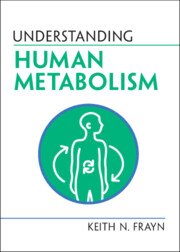Book contents
- Understanding Human Metabolism
- Series page
- Understanding Human Metabolism
- Copyright page
- Reviews
- Contents
- Foreword
- Preface
- Acknowledgements
- 1 What Is Metabolism?
- 2 Metabolic Fuels
- 3 Metabolic Pathways
- 4 Communication Systems in Human Metabolism
- 5 ATP: The Common Currency of Metabolic Energy
- 6 Metabolism in Daily Life
- 7 Metabolism Is So Adaptable
- 8 Metabolic Interactions between Nutrients
- 9 Metabolic Disorders
- Concluding Remarks: Human Metabolism in Context
- Summary of Common Misunderstandings
- References
- Figure Credits
- Index
5 - ATP: The Common Currency of Metabolic Energy
Published online by Cambridge University Press: 25 August 2022
- Understanding Human Metabolism
- Series page
- Understanding Human Metabolism
- Copyright page
- Reviews
- Contents
- Foreword
- Preface
- Acknowledgements
- 1 What Is Metabolism?
- 2 Metabolic Fuels
- 3 Metabolic Pathways
- 4 Communication Systems in Human Metabolism
- 5 ATP: The Common Currency of Metabolic Energy
- 6 Metabolism in Daily Life
- 7 Metabolism Is So Adaptable
- 8 Metabolic Interactions between Nutrients
- 9 Metabolic Disorders
- Concluding Remarks: Human Metabolism in Context
- Summary of Common Misunderstandings
- References
- Figure Credits
- Index
Summary
I know I am not alone in my fascination with steam engines. The steam engine is an external combustion engine. The fuel burns in the firebox. It produces heat. The heat is then used to generate steam in the boiler. The steam, under pressure, is then piped to the cylinders where it acts to move the pistons and hence to do work like moving a ship through water, or an engine along the rails, or, in the case of a stationary pumping engine, lifting water out of a deep mine. So the steam is a way of transferring the energy liberated when the fuels are burned, to the place where energy is needed to do work.
- Type
- Chapter
- Information
- Understanding Human Metabolism , pp. 59 - 76Publisher: Cambridge University PressPrint publication year: 2022

